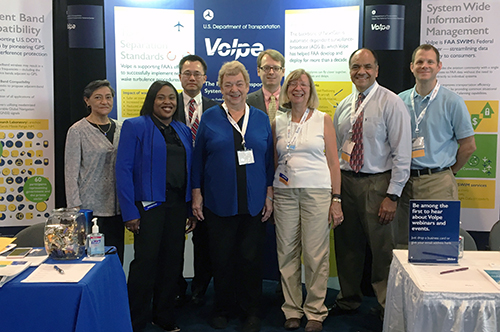Insights from ATCA 2016
For as long as Volpe has existed—more than 45 years—we have developed aviation procedures and systems that improve the efficiency and safety of aviation. Today, our aviation experts specialize in planning, researching, testing, and evaluating the Federal Aviation Administration’s (FAA) NextGen program.
Each year, Volpe takes part in the aviation industry’s conversation by attending the Air Traffic Control Association (ATCA) annual conference. Volpe staff, including Director Anne Aylward, attended ATCA 2016 to share our work in aviation with hundreds of government and industry partners, and to learn from other experts in the field.

At ATCA 2016, Volpe staff contributed to discussions on aviation planning, research, testing, and evaluation. Staff at Volpe's ATCA booth (left to right): Nidia Jimenez, Tandra Sanders, Jason Lu, Volpe Director Anne Aylward, Carl Snyder, Phyllis Hutchinson, Tony Colon, and Clay Reherman. (Volpe photo)
“Technology is growing exponentially, and the number of aviation accidents will approach zero in the coming years,” said Jim Hill, our former chief of air traffic management, who retired at the end of October. “We’re going to need new and better air traffic solutions, with air traffic centered around information, not systems. We’ll see large pilotless oceanic air cargo and commercial drone lanes in, out, and around cities. I’m excited for these and other new technologies becoming real.”
Here are a few insights from Volpe staff who attended ATCA 2016:
- NextGen is on course, delivering benefits, and will meet its major air traffic management objectives by 2025.
- Unmanned aircraft are here, and FAA and its industry partners are focused on refining the basic requirements, fundamental responsibilities, and organizational structures needed to integrate drones into the national airspace.
- Different generations prefer different work tools, information systems, and motivation and career strategies. There are significant generational differences in how staff think, what they value, and how they gather and process information.
- FAA can work toward establishing stable funding streams by setting priorities, coordinating with industry, and gathering input from key stakeholders. There may be innovative approaches to incorporate new airspace entrants, like commercial drone users, into FAA’s funding structure.
- There are open, ongoing discussions among industry and FAA on how to ensure equitable and collaborative access to airspace—including for air carrier operations, commercial operations, drones, and business aircraft—and predicting impacts of weather events.
- Collaborative, cross-agency discussions are upcoming for the new Spectrum Efficient National Surveillance Radar program, which aims to integrate long- and short-range surveillance and weather updates into a single platform.
- Volpe has staff who can support deployment of virtual, unstaffed control towers in the U.S. This technology is being carefully watched at Volpe and by FAA and industry partners.
Visit Volpe’s Center for Air Traffic Systems and Operations to learn more.

